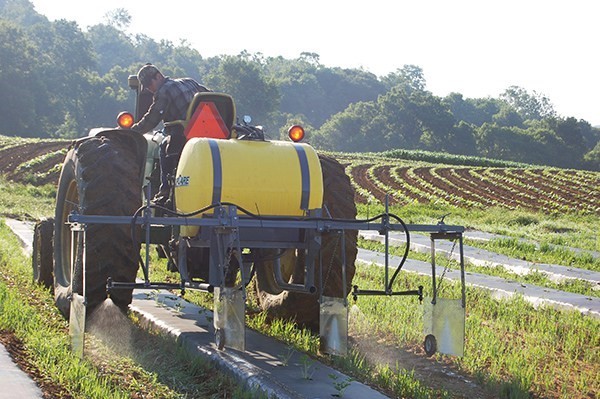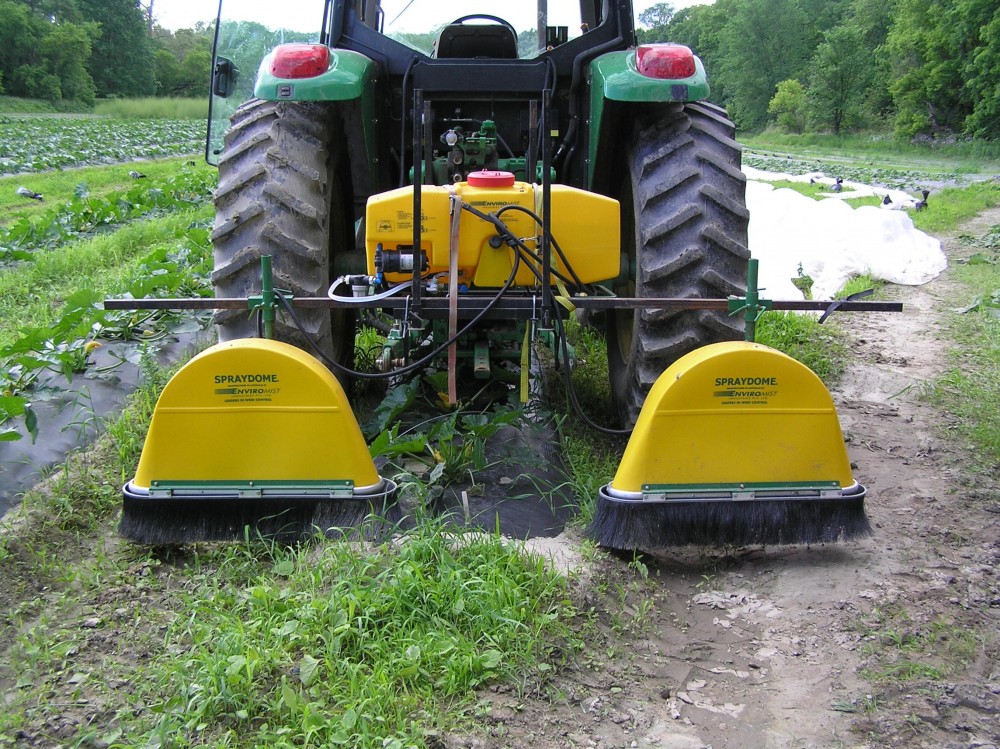Weed Control and Plastic Mulches
Chuck Bornt, Team Leader, Extension Vegetable Specialist
Eastern New York Commercial Horticulture
As the weather warms up and plastic mulches are being applied to get ready for our summer crop plantings, the question of what to do about weed control in the beds and between the beds is a common one that I get. Unfortunately, I don't have a silver bullet for you but have a couple of thoughts. First, there are a few herbicides that are labeled for use under the plastic on a few crops. However, the recommended use is to make the beds first, apply the herbicides and then lay the plastic mulch which is not usually how we manage our plasticulture systems - as we normally like to bed and mulch all in the same pass. I have yet to see anyone modify their mulch layer to apply herbicides while laying their mulches (if anyone has, please let me know I would love to see it!). The other thing to consider is that many of these products are very sensitive to moisture and often require it to activate them. Lastly, I worry about injury to our crop when using these herbicides, especially as many of you are using water-wheel transplanters which could in theory reactivate the herbicide and concentrate it around the rootball. I think educating your employees planting to make the smallest hole possible and making sure that plant gets off to a good start may be just as good as the pre-plant herbicides! However, if you want to try some herbicides under mulches this is what is labeled to my knowledge:
Herbicides Labeled for Use Under Plastic Mulch
Herbicide
Crop(s)
Devrinol
Tomatoes, Peppers, Eggplant
Prefar
Eggplant, Peppers, Cucumbers, Melons, Squash
Sandea
Tomatoes, Cucumbers, Melons, Squash, Watermelon (need to wait 7 days after application to plant crop)
Prowl H2O
Eggplant
So the other question that comes up is how to control weeds between the rows and again, I don't have a silver bullet, but there are certainly more options! The first thing that I would tell you is I do not recommend applying any of these materials broadcast over the top of your mulch before planting! I think you are taking a risk that even after a couple of rains, some of the herbicide may remain on the plastic and could concentrate in the planting hole after you've planted with a rain - especially in cases where beds are not uniformly full and you have dips in your beds where water can gather on the plastic. I think the best method is to fit the field, lay your plastic and then using either very directed sprays or better yet, a shielded sprayer, apply the herbicides between the beds, just letting the spray contact the shoulders of the bed. I've seen some homemade shielded units made from plastic totes to old wooden apple crates!
My rule of thumb for row middle applications is, if the material is labeled on the crop, then it can be used in the row middles too unless otherwise specified on the label that it cannot be used between the rows. Using a pre-emergent or combination of pre-emergents before transplanting is the best strategy in my mind as you minimize the risk of drift and hitting your crop. However, if you can't get right in there to apply them after laying your mulch or planting and weeds are already starting to grow, I would recommend tank mixing in a contact herbicide such as Gramoxone (or other formulations of the active ingredient paraquat) to your pre-emergent materials as a shielded, directed spray. Why paraquat instead of glyphosate (Round-Up etc.)? Paraquat will only kill what it comes in contact with (so coverage is essential). So if a little drift moves onto your plant, it will only kill the area that it comes in contact with and leave some tan spots. Whereas a small amount of glyphosate will translocate and potentially kill or really hurt your crop and I'd rather be safe than sorry.
Below is a list of some herbicides that could be used between rows of plastic mulch on various crops. This is not to be used in place of a label as in some instances a product may be labeled on some but not all crops in the same family (for example when I say brassicas, that includes cabbage, broccoli, etc., but these products may not be labeled on all members of the brassica family so please read the label before using).
Herbicides Labeled for Between Rows of Plastic Mulches on Various Vegetable Crops
Herbicide
Crop(s)
Dual Magnum (metolachlor)
Tomatoes, Peppers, Cucurbits, some Brassicas, Lettuce, Onion
Prefar (bensulide)
Eggplant, Peppers, Cucumbers, Melons, Squash, Brassicas, Lettuce
Sandea (halosulfuron)
Tomatoes, Cucumbers, Melons, Squash, Watermelon, Peppers, Eggplant
Prowl H2O (pendimethalin)
Eggplant, Pepper, Tomato, Onion, Brassicas
Reflex (fomesafen)
Tomatoes, Peppers, Eggplant,
Dimetric, Sencor (metribuzin)
Tomatoes
Strategy (clomazone + ethalfluralin)
Cucumber, Melon, Pumpkin, Squash
 Shielded sprayer manufactured by Crop Care (Photo: http://www.cropcareequipment.com)
Shielded sprayer manufactured by Crop Care (Photo: http://www.cropcareequipment.com) Hooded sprayer manufactured by Micron Sprayers Ltd and Enviromist Industries Pty.
Hooded sprayer manufactured by Micron Sprayers Ltd and Enviromist Industries Pty.
Upcoming Events
2026 Winter Cut Flower Webinar Series
January 6, 2026
The fifth annual CCE Cut Flower Webinar Series begins on January 6, 2026 and continues over 5 weeks on Tuesdays. This is a very popular series of online events you won't want to miss, with topflight speakers, a wide variety of subjects concerning growing cut flowers and plenty of interaction between speakers and attendees.
Tuesdays 1pm-3pm January 6, 2026 - February 3, 2026 (The webinar held on February 3 will run 1pm-4pm)
Cost: $60.00 for all five sessions, $20 for single sessions
Webinars will be recorded, and all the recordings will be sent to registrants for future review.
Expanding Farm Sales: Markets, Profits, and Branding Series
January 10, 2026
Looking to diversify where you sell your farm products? This four-part workshop series helps farmers explore new opportunities in direct-to-consumer, wholesale, and institutional markets. Learn how to meet buyer expectations, price for profitability, and build lasting relationships that support your business goals. Participants will strengthen marketing and communication skills, evaluate which sales channels best fit their farm, and connect with buyers, distributors, and local partners who can help expand their reach. Whether you're just starting out or ready to grow your market presence, this program will help you chart the right path for your farm's future.
Four Session Series: Saturdays from 10AM to Noon, January 10-January 31, 2026
Attend at one of three locations: Schoharie Extension Center - Cobleskill, NY; Otsego Education Center - Cooperstown, NY; Via Zoom
Pre-registration is requested! Fee: $25 Register Here
Any questions can be directed to Kelley Doolin at kmd322@cornell.edu
Pesticide Applicator Certification Exam Prep Course
January 13 - January 14, 2026
Join ENYCHP specialists for an in-depth review of topics covered on the NYS DEC pesticide applicator certification exam. This two-day virtual course includes explanation of key concepts on the core exam, test-taking tips for the core and category exam, practice questions, and Q&A with instructors. Course materials, including program recordings, practice exams, and DEC materials will be available to registrants after the program. This training is geared toward certification categories 1A (agricultural plant), 21 (field and forage), 22 (fruit), and 23 (vegetable).












































